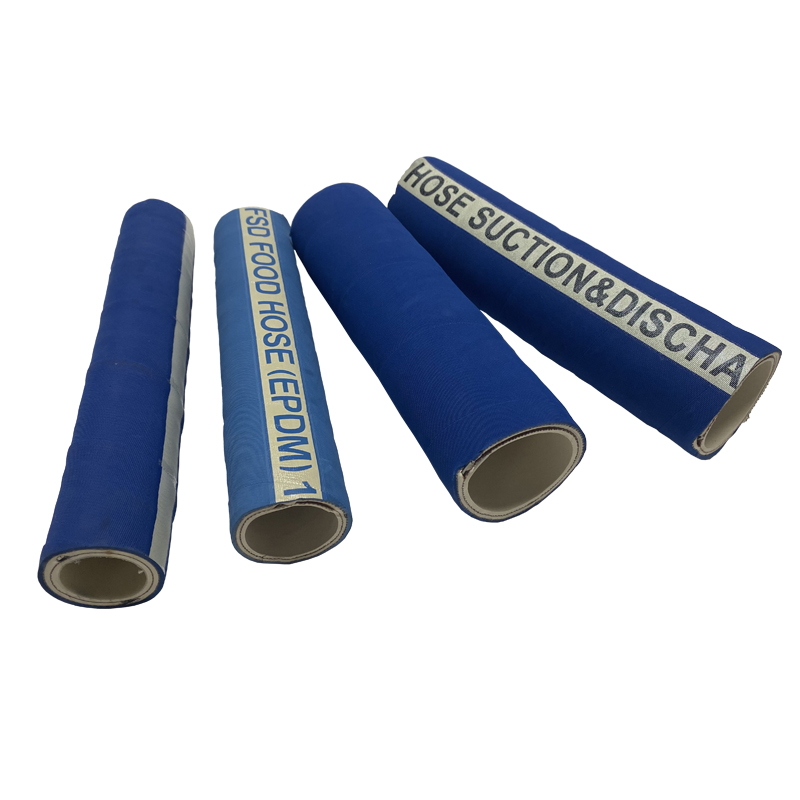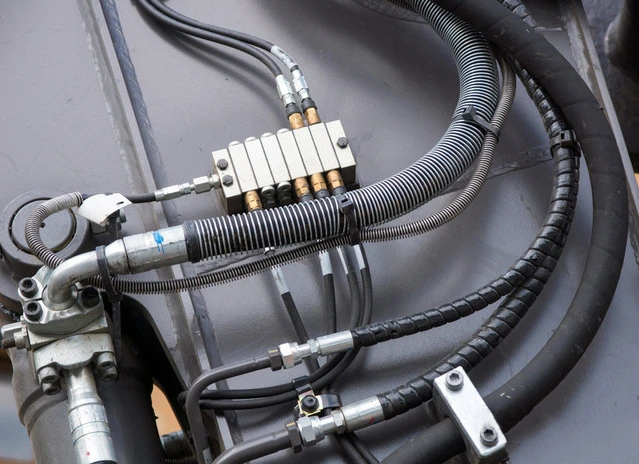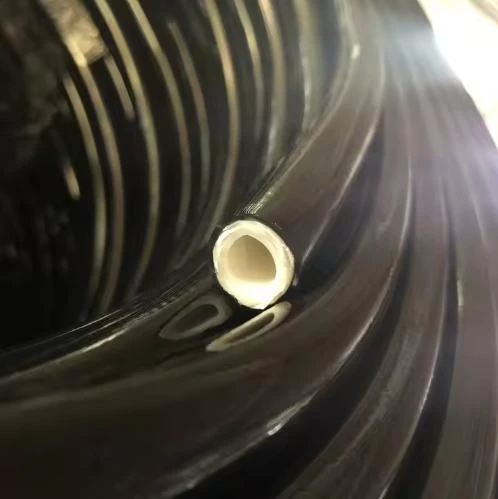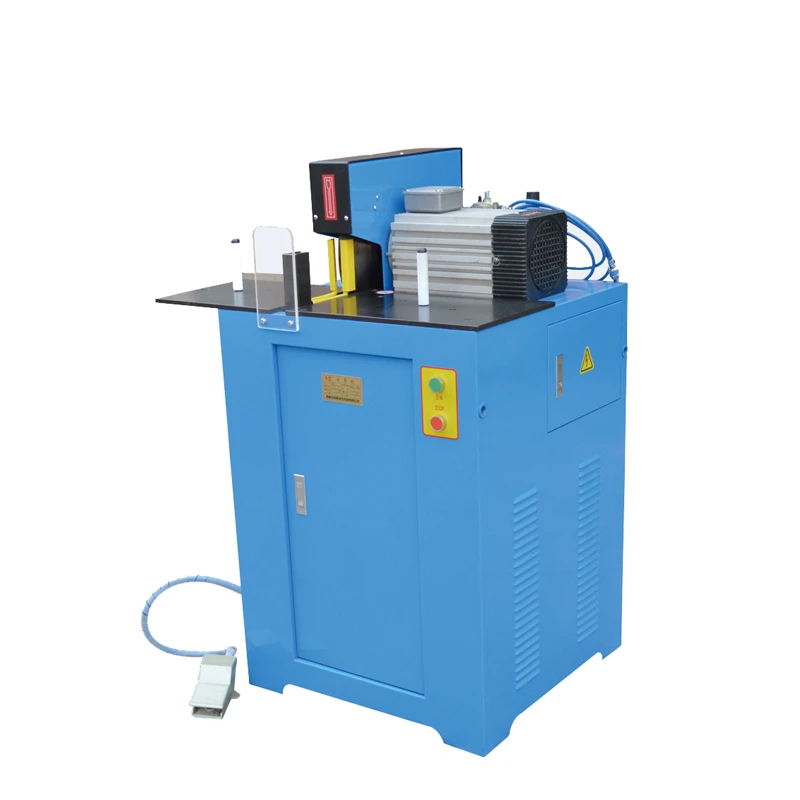የኬሚካል ቱቦ
የኬሚካል ቱቦ በተለይ አሲድ፣ አልካላይስ፣ መፈልፈያ፣ ዘይቶች እና ሌሎች አደገኛ ወይም ጠበኛ ፈሳሾችን ጨምሮ የተለያዩ ኬሚካሎችን በደህና ለማጓጓዝ የተነደፈ የቧንቧ አይነት ነው። እነዚህ ቱቦዎች ደህንነቱ የተጠበቀ እና ውጤታማ ስራን ለማረጋገጥ ከዝገት, ከኬሚካላዊ ጥቃት እና ከመቧጨር መቋቋም ከሚችሉ ቁሳቁሶች የተሠሩ ናቸው. የኬሚካላዊ ቱቦ ውስጠኛ ሽፋን በተለምዶ ከተሰራው ጎማ, PTFE (ቴፍሎን) ወይም ሌሎች ልዩ ውህዶች ለተለያዩ ኬሚካሎች ከፍተኛ የመቋቋም ችሎታ ይሰጣል. የውጪው ሽፋን ጥንካሬን ለመጨመር እና ከሜካኒካዊ ጉዳት ለመከላከል ብዙውን ጊዜ በተጣራ የብረት ሽቦ ወይም የጨርቃጨርቅ ንብርብሮች የተጠናከረ ነው. የኬሚካል ቱቦዎች አደገኛ ወይም ከፍተኛ ምላሽ ሰጪ ቁሳቁሶችን ማስተላለፍ በሚያስፈልግባቸው የኬሚካል ማምረቻዎች፣ ፋርማሲዩቲካልስ፣ ግብርና፣ ዘይትና ጋዝ እና የምግብ ምርትን ጨምሮ በብዙ ኢንዱስትሪዎች ውስጥ ጥቅም ላይ ይውላሉ። ለምሳሌ በኬሚካል ኢንዱስትሪ ውስጥ እነዚህ ቱቦዎች የኢንዱስትሪ ኬሚካሎችን በታንኮች እና በማቀነባበሪያ መሳሪያዎች መካከል ለማስተላለፍ ያገለግላሉ, በግብርና ላይ ደግሞ ፀረ-ተባይ እና ማዳበሪያን ለመርጨት ያገለግላሉ. የኬሚካል ቱቦዎች በነዳጅ እና በጋዝ ኢንዱስትሪ ውስጥ ነዳጅ እና ቅባቶችን ለማጓጓዝ ያገለግላሉ። የኬሚካላዊ መበላሸት, ግፊት እና ከፍተኛ ሙቀትን የመቋቋም ችሎታቸው ደህንነት እና አስተማማኝነት በጣም አስፈላጊ በሆኑ መተግበሪያዎች ውስጥ አስፈላጊ ያደርጋቸዋል.
የኬሚካል ቱቦን በሚመርጡበት ጊዜ ምን ነገሮች ግምት ውስጥ መግባት አለባቸው?
የኬሚካል ቱቦን በሚመርጡበት ጊዜ, ይህ የኬሚካል ቱቦ ለተለየ አተገባበር ተስማሚ መሆኑን ለማረጋገጥ በርካታ ቁልፍ ነገሮችን ግምት ውስጥ ማስገባት አስፈላጊ ነው. ለመገምገም የመጀመሪያው ነገር የቧንቧ እቃዎች ከተጓጓዙ ኬሚካሎች ጋር ተኳሃኝነት ነው. የተለያዩ ኬሚካሎች በቧንቧ እቃዎች ላይ የተለያየ ደረጃ ያላቸውን የውድቀት መጠን ሊያስከትሉ ስለሚችሉ ከተወሰኑ የኬሚካላዊ ዓይነቶች መቋቋም ከሚችሉ ቁሳቁሶች የተሰራ ኬሚካላዊ ተከላካይ ቱቦን መምረጥ በጣም አስፈላጊ ነው. እንደ ኬሚካዊ የጎማ ቱቦዎች ያሉ የተለመዱ የኬሚካል ቱቦዎች፣ ሰው ሠራሽ ጎማዎች (እንደ EPDM እና Nitrile)፣ PTFE እና ፖሊ polyethylene ያካትታሉ፣ እነዚህም ጥሩ ኬሚካላዊ የመቋቋም አቅም አላቸው።
የኬሚካል ቱቦው የግፊት ደረጃ ሌላው አስፈላጊ ነገር ነው. ከፍተኛ-ግፊት መስፈርቶች ላሏቸው ስርዓቶች ከፍተኛ ግፊት ያለው የኬሚካላዊ ቱቦ መመረጥ አለበት ምክንያቱም የስርዓቱን ግፊት ሳይሳካለት መቆጣጠር አለበት. በተጨማሪም ፣ የሙቀት መጠኑ በጣም አስፈላጊ ነው ፣ ምክንያቱም አንዳንድ ኬሚካሎች በከፍተኛ ወይም ዝቅተኛ የሙቀት መጠን በኬሚካዊ ቱቦ ውስጥ መተላለፍ አለባቸው።
ተለዋዋጭነት ሌላው አስፈላጊ ትኩረት ነው, በተለይም በተደጋጋሚ መንቀሳቀስ ወይም መታጠፍ በሚያስፈልጋቸው ስርዓቶች ውስጥ ለሚጠቀሙ ተለዋዋጭ የኬሚካል ቱቦዎች. ትክክለኛውን ፍሰት ለማረጋገጥ እና አላስፈላጊ የግፊት መጥፋትን ለማስወገድ የቧንቧው ርዝመት እና ዲያሜትር ከስርዓቱ መስፈርቶች ጋር እንዲመጣጠን መመረጥ አለበት። የኬሚካል ቱቦውን ጥንካሬ ለመጨመር እና መገጣጠም ወይም መሰባበርን ለመከላከል እንደ የተጠለፈ የብረት ሽቦ ወይም ስፒል ብረት ሽቦ ያሉ ማጠናከሪያዎች ይታከላሉ።
በመጨረሻም የኬሚካል ቱቦው አግባብነት ያላቸው የኢንዱስትሪ ደረጃዎችን እና የምስክር ወረቀቶችን ማሟላቱን ያረጋግጡ, ለምሳሌ በኤፍዲኤ, ISO, ወይም EN ደረጃዎች የተቀመጡትን, ለተወሰኑ አፕሊኬሽኖች ለመጠቀም ደህንነቱ የተጠበቀ መሆኑን ለማረጋገጥ. እነዚህን ሁኔታዎች ግምት ውስጥ በማስገባት በጊዜ ሂደት አስተማማኝ እና አስተማማኝ አገልግሎት የሚሰጥ የኬሚካል ቱቦ መምረጥ ይችላሉ.
የኬሚካል ቱቦዎችን ለመገንባት ምን ዓይነት ቁሳቁሶች በብዛት ጥቅም ላይ ይውላሉ, እና ለምን ተስማሚ ናቸው?
የኬሚካል ቱቦዎች የተገነቡት በኢንዱስትሪ እና በንግድ ትግበራዎች ውስጥ ሊያጋጥሟቸው ከሚችሉት ሰፊ ኬሚካሎች እና አስቸጋሪ ሁኔታዎች ለመቋቋም ከተመረጡት ቁሳቁሶች ነው. ለኬሚካል ቱቦዎች በብዛት ጥቅም ላይ ከሚውሉት ቁሳቁሶች አንዱ እንደ ኢፒዲኤም (ኤቲሊን ፕሮፓይሊን ዳይነ ሞኖመር) ያሉ ሰው ሰራሽ ጎማ ሲሆን ይህም ለአሲድ፣ ለአልካላይስ እና ለአየር ሁኔታ በጣም ጥሩ የመቋቋም ችሎታ አለው። ናይትሪል ጎማ ዘይት፣ ነዳጅ እና መፈልፈያዎችን ስለሚቋቋም የፔትሮሊየም ምርቶችን ወይም አደገኛ ኬሚካሎችን ለማጓጓዝ ተመራጭ ያደርገዋል። PTFE (ቴፍሎን) ለኬሚካላዊ ቱቦዎች ሌላ ተወዳጅ ቁሳቁስ ነው, ምክንያቱም ምላሽ የማይሰጥ ባህሪው እና ለተለያዩ ጠበኛ ኬሚካሎች እና ከፍተኛ ሙቀት. የ PTFE ቱቦዎች በተለይ ጠንካራ አሲዶችን ፣ ሌሎች ቁሳቁሶችን የሚያበላሹ ፈሳሾችን ለማስተላለፍ ተስማሚ ናቸው። በተጨማሪም ፖሊ polyethylene በተወሰኑ መተግበሪያዎች ውስጥ ለኬሚካላዊ መቋቋም እና ተለዋዋጭነት በተለይም በግብርና እና በምግብ ደረጃ ኬሚካላዊ ቱቦዎች ውስጥ ጥቅም ላይ ይውላል። ጥንካሬን እና ጥንካሬን ለመጨመር, የኬሚካል ቱቦዎች ብዙውን ጊዜ በብረት ሽቦ ወይም በጨርቃጨርቅ ጥልፍ የተጠናከሩ ናቸው. እነዚህ ማጠናከሪያዎች ቱቦው በግፊት ውስጥ እንዳይወድቅ ይከላከላሉ, ተለዋዋጭነትን ያረጋግጣሉ እና ከውጭ ሜካኒካዊ ጉዳት ይከላከላሉ. የእነዚህ ቁሳቁሶች ጥምረት የኬሚካላዊ ቱቦዎች የተነደፉትን ኃይለኛ ንጥረ ነገሮችን በአስተማማኝ እና በአስተማማኝ ሁኔታ ማስተናገድ መቻላቸውን እና ፈታኝ በሆኑ አካባቢዎች ውስጥ የመተጣጠፍ ችሎታን እና ዘላቂነትን ይጠብቃሉ.
Decoding the Corrosion-Resistant Core of Chemical Hoses: Material Science and Engineering Design
SINOPULSE combines advanced material science with precision engineering to create flexible chemical hoses that excel in transporting aggressive fluids. The ability to resist corrosion hinges on carefully selected inner tube materials, reinforced structures, and protective layers—each element designed to withstand specific chemical challenges. Let’s explore the technical foundations that make SINOPULSE chemical-resistant hoses the trusted choice for demanding industrial applications.
1. Fluoropolymer Liners: The First Line of Defense
At the heart of SINOPULSE chemical transfer hoses lies a fluoropolymer inner tube, typically PTFE (Polytetrafluoroethylene) or FEP (Fluorinated Ethylene Propylene). These materials owe their exceptional corrosion resistance to a unique molecular structure: a tightly packed carbon-fluorine bond (C-F) that is one of the strongest in polymer chemistry. This bond resists breakage from strong acid (e.g., sulfuric acid), strong base (e.g., sodium hydroxide), and solvents (e.g., acetone), making PTFE-lined hoses compatible with over 98% of industrial chemicals. For example, in pharmaceutical manufacturing, PTFE-lined hoses safely transport concentrated hydrochloric acid without swelling or degradation, maintaining fluid purity and hose integrity over years of use.
2. Elastomeric Compounds for Specialized Chemistries
When applications demand flexibility at lower temperatures or resistance to specific chemical families, SINOPULSE employs high-performance elastomers like fluoroelastomer (FKM) or ethylene-propylene-diene monomer (EPDM). FKM, with its cross-linked fluorocarbon structure, excels in resisting petroleum-based solvents and high-temperature oxidizers, making it ideal for aerospace hydraulic fluids. EPDM, conversely, thrives in aqueous environments, providing superior resistance to ketones and steam—critical for wastewater treatment systems where dilute acids and alkalis are common. These materials undergo rigorous swelling tests (e.g., ≤0.5% volume change in ASTM D471) to ensure long-term reliability.
3. Reinforcement Layers: Structural Integrity Under Pressure
Even the most corrosion-resistant liners require robust support to handle high-pressure applications. SINOPULSE high-pressure chemical hoses integrate braided or spiral-wound reinforcement layers, such as stainless steel wire or aramid fibers, to distribute internal pressure evenly. A 304 stainless steel braid, for instance, adds mechanical strength capable of withstanding 500 bar (7250 PSI) burst pressure while remaining non-reactive to most chemicals. This design prevents liner collapse or delamination, ensuring safe fluid transfer in refinery pipelines or chemical reactor feed systems.
4. Protective Outer Covers: Shielding Against External Threats
The outer layer of SINOPULSE chemical hoses is engineered to protect against external hazards like abrasion, UV radiation, and physical impact. Polyurethane (PU) or chloroprene rubber covers offer excellent resistance to cutting and weathering, vital for outdoor chemical transfer in mining or offshore platforms. For static-sensitive environments, anti-static additives in the outer layer dissipate electrical charges, eliminating ignition risks when handling flammable solvents like methanol.
Engineered for Synergy: How Layers Work Together
The true power of SINOPULSE chemical-resistant hoses lies in the synergy between layers: the fluoropolymer liner repels chemical attack, the reinforcement layer maintains structural stability, and the outer cover shields against environmental damage. This tri-layer system undergoes rigorous testing, including permeation resistance (ASTM F739) to ensure minimal chemical leakage and thermal cycling to validate performance across extreme temperatures.
In industries where chemical compatibility and safety are non-negotiable—from petrochemical processing to semiconductor manufacturing—SINOPULSE’s material expertise and engineering precision deliver chemical hoses that redefine corrosion resistance. Trust our solutions to protect your processes, people, and profits, no matter how aggressive the fluid.
Precision Fluid Transfer: The Stringent Demands of High-Purity Chemical Hoses in Semiconductor and Pharmaceutical Industries
In the semiconductor and pharmaceutical sectors, where precision and purity are non-negotiable, SINOPULSE, a leading chemical hose manufacturer, rises to the challenge with specialized high-purity chemical hoses. These industries demand hoses that not only resist corrosion but also maintain the integrity of ultra-sensitive fluids, and SINOPULSE’s engineered solutions meet these exacting standards.
Purity as the Cornerstone
Semiconductor manufacturing, particularly in wafer fabrication, relies on highly corrosive etching agents and ultra-pure water. SINOPULSE’s flexible chemical hoses feature smooth-bore EPDM liners. In pharmaceutical production, where drug safety is paramount, our hoses comply with FDA and USP Class VI standards, guaranteeing that no chemical residues leach into medications during transfer. For instance, when transporting sterile solutions for injectable drugs, SINOPULSE chemical transfer hoses maintain the fluid’s sterility throughout the process.
Controlled Environment Compatibility
Both industries operate in tightly controlled environments. Semiconductor facilities require hoses that can withstand rapid temperature fluctuations during plasma etching and annealing processes. SINOPULSE’s high-purity chemical hoses, reinforced with inert materials like stainless steel braids, retain their structural integrity under extreme conditions without reacting with aggressive chemicals. In pharmaceutical cleanrooms, where particulate matter is strictly monitored, our hoses are designed to prevent outgassing, ensuring that volatile compounds do not compromise air quality or product purity.
High-Pressure Performance with Precision
Semiconductor wet processing and pharmaceutical synthesis often involve high-pressure fluid delivery. SINOPULSE high-pressure chemical hoses are engineered to handle pressures up to 500 bar (7250 PSI) while maintaining precision flow control. The multi-layer construction, combining a corrosion-resistant fluoropolymer inner tube with a robust reinforcement layer, ensures consistent performance without leaks or pressure drops. This reliability is crucial in semiconductor lithography, where even a minor fluid deviation can render an entire wafer batch defective.
Compliance Beyond Standards
SINOPULSE understands that these industries operate under strict regulatory frameworks. Our chemical-resistant hoses undergo rigorous testing, including biocompatibility evaluations and permeation resistance assessments, to meet international guidelines. Whether it’s safeguarding the purity of semiconductor-grade chemicals or ensuring the safety of pharmaceutical formulations, SINOPULSE’s high-purity hoses are the trusted choice for precision fluid transfer in these high-stakes industries.












